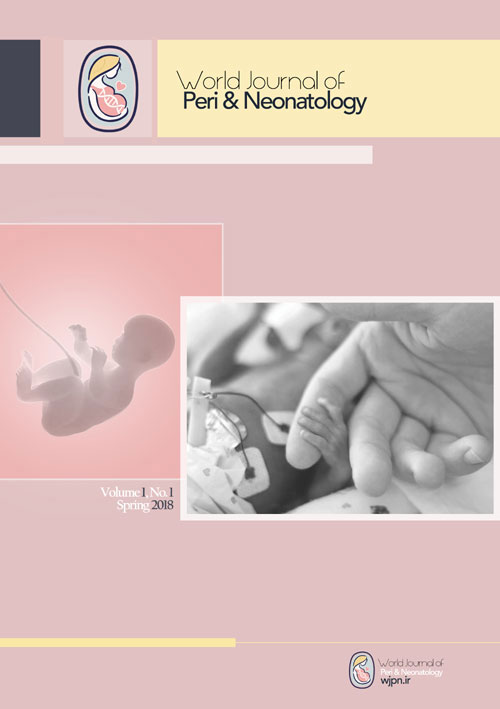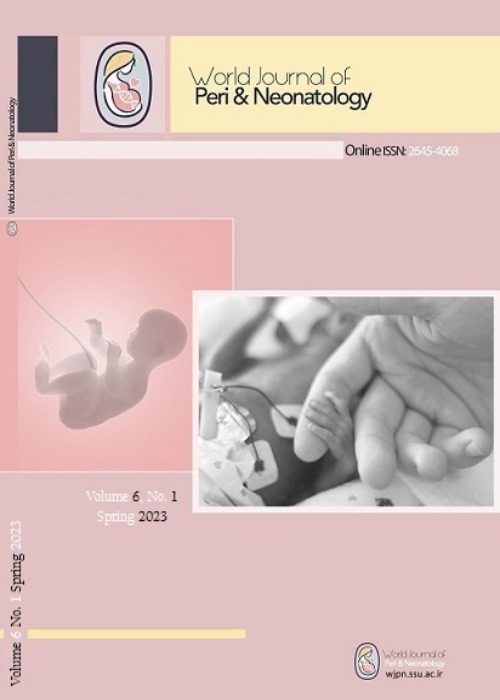فهرست مطالب

Journal of World Journal of Peri and Neonatology
Volume:4 Issue: 1, Winter-Spring 2021
- تاریخ انتشار: 1400/08/16
- تعداد عناوین: 8
-
Pages 1-6BackgroundAnxiety, depression, and stress during the pregnancy period are usually overlooked in women despite their detrimental effects on the mother and infant. Studies have shown an increase in the risk of behavioral and psychological problems in an infant's life because of the mother's exposure to negative excitement and stress before childbirth. In the present study, we aimed to assess the effect of maternal anxiety, depression, and stress during pregnancy on neonatal growth indices at birth.MethodsThis longitudinal survey was done on 102 pregnant women referred to the obstetrics clinic of Shahid Sadoughi Hospital of Yazd for prenatal care from September 2019 to March 2020. They were asked to fulfill two questionnaires related to the study. After delivery, the further information and growth indices of neonates were extracted by telephone.ResultsRegardless of the severity of depression, anxiety, and stress, a significant relationship was found between maternal age and stress (P= 0.033), so in mothers with younger age, pregnancy stress was more. Moreover, the study showed a significant relationship between height and maternal anxiety (P = 0.018).ConclusionBased on the findings of this study and due to the possible association of neonatal indices with maternal anxiety, depression, and stress during pregnancy, more attention to maternal emotional health seems necessary.Keywords: maternal, anxiety, depression, stress, Neonatal, growth indices
-
Pages 7-13Background
Retinopathy of prematurity (ROP) is an important cause of preventable blindness in children. The aim of this study was to examine the association of the polymorphisms at Factor V Leiden (FVL) and methylene tetrahydrofolate reductase (MTHFR) gene with risk of ROP.
MethodsA total of 106 neonates with ROP and 110 healthy neonates were enrolled. The FVL G1691A and MTHFR C677T and A1298C polymorphisms were genotyped by PCR-RFLP assay.
ResultsThere was a significant association between FVL G1691A polymorphism and an increased risk of ROP. However, the MTHFR C677T and A1298C polymorphisms were not associated with risk of ROP.
ConclusionFVL G1691A polymorphism may be risk factor for development of ROP in neonates. However, there was no significant association between MTHFR C677T and A1298C polymorphisms and risk of ROP. However, it is critical that larger and well-designed studies in different ethnicities are needed to confirm our conclusions.
Keywords: Retinopathy of Prematurity, Neonate, Factor V Leiden, MTHFR Gene -
Pages 14-22Background
The previous published data on the association between interferon regulatory factor 6 (IRF6) polymorphisms and non-syndromic Cleft Lip/Palate (NSCL ± P) risk remained inconclusive. The aim of this study was to conduct a meta-analysis to further assess the associations.
MethodsA comprehensivesearch in PubMed, EMBASE, Web of Science, and CNKI for all eligible studies up July 2021.
ResultsA total of 23 studies with 6,161 cases and 8,919 controls were selected for this meta-analysis. Overall pooled analysis suggest a significant association between IRF6 rs2235371 polymorphism and CL±P risk under all the five genetic models, i.e., allele (A vs. G: OR=0.754, 95% CI 0.628-0.905, P=0.002), homozygote (AA vs. GG: OR=0.621 95% 0.405-0.953, P=0.029), heterozygote (AC vs. GG: OR=0.619, 95% CI 0.485-0.791, P≤0.001), dominant (AA+AG vs. GG: OR=0.550, 95% CI 0.381-0.794, P=0.001) and recessive model (AA vs. AG+GG: OR=0.583, 95% CI 0.423-0.804, P=0.001). Subgroup analysis by ethnicity showed that rs2235371 was associated with NSCL±P risk in Asians.
ConclusionThis meta-analysis provides strong evidences that IRF6 rs2235371 might be associated with risk of NSCL ± P.
Keywords: Cleft Lip, Palate, Craniofacial, IRF6 gene, Polymorphism, Meta-analysis -
Pages 23-39Background
The aim of this meta-analysis was to estimate the prevalence of cesarean section (CS), preterm birth, stillbirth, and low birth weight deliveries (LBWD) in pregnant women with SARS-COV-2 infection.
MethodsAll relevant studies were searched up to 30 February 2021.
ResultsA total of 47 studies with 5970 infected pregnant women were included. There were 1010 CS, 55 stillbirths, 524 preterm birth, and 82 with LBWD. Pooled data showed that the prevalence of CS, preterm birth, stillbirth, and LBWD among women with SARS-COV-2 infection was 29.6% (95% CI 0.081-0.160), 2.1% (95% CI 0.081-0.160), 11.5% (95% CI 0.081-0.160), and 2.1% (95% CI 0.081-0.160), respectively. Stratified analysis revealed that these pregnancy outcomes among Asian women were higher than Caucasians.
ConclusionOur combined data revealed that the CS prevalence (29.6%) was the highest followed by preterm birth (11.5%), stillbirth (2.1%), and LBWD (2.1%) among women with COVID-19.
Keywords: SARS-CoV-2, COVID-19, Preterm Birth, Stillbirth, Cesarean Section, Low Birth Weight -
Pages 40-49Background
Jaundice is the most common clinical problem among newborns. It could be caused by different factors, including infections such as urinary tract infection (UTI). We investigated the prevalence of UTI in Iranian newborns with jaundice and prolonged jaundice in this study based on a larger sample of existing data.
MethodsWe searched the databases of PubMed, Web of Sciences, Scopus, CNKI, SciELO, and Google Scholar for English articles, and a search was also done in Persian in Magiran and Scientific Information Database (SID) published until July 2021. Data analysis was performed by Comprehensive Meta-Analysis (CMA) version 2.0 software.
ResultsThis study included 19 eligible articles out of approximately 240 retrieved articles. The prevalence of UTIs in neonates with jaundice was estimated by pooling the data from 7416 neonates with jaundice. Of those, 369 cases had UTI. Combined data revealed that the prevalence of UTI in neonates with jaundice was 5.4% (95% CI 0.032-0.089, P ≤ 0.001) and there was no publication bias.
ConclusionThe overall prevalence of UTI in Iranian newborns with jaundice was 5.4%. However, more studies with a large sample size are required for better results. Also our review showed a screening of UTI should be considered for infants with jaundice, especially prolonged jaundice.
Keywords: Urinary Tract Infection, Jaundice, Newborns, Prevalence, Infection -
Pages 50-59
Congenital heart disease (CHD) may have serious effects on the course of COVID-19. Limited data were available on CHD in neonates with COVID-19. This study aimed to review the cardiac complications in neonates infected with COVID-19. Some studies showed that myocardial injury in adult patients is often correlated with a fatal outcome. But, scientific evidence in infants is rare, although several reports were published with the description of cardiac involvement in COVID-19 pediatric patients. In these young subjects, a background of surgically treated CHD seems to be a predisposing factor. Numerous studies showed Multisystem inflammatory syndrome in children (MIS-c) is a deadly demonstration of COVID-19 with cardiac involvement. The underlying pathophysiology of COVID-19-associated cardiovascular complications is not fully understood, although direct viral infection of the myocardium, systemic inflammatory response, coagulation abnormalities and thrombosis and hypoxia have been suggested as possible mechanisms of cardiac complications. It seems COVID-19 can affect different parts of the heart; however, the myocardium is more involved. The mechanisms of pathogenesis of cardiovascular implications in adults and infants are similar but CHD and MIS-c in infants are more important. Further studies on the effects of COVID-19 on the neonatal cardiovascular system are needed.
Keywords: COVID-19, Cardiac, Complications, Heart Disease, Infant -
Pages 60-64Background
Several numbers of studies have reported that coronavirus disease-2019 (COVID-19) in infants and children have shown milder symptoms and a better prognosis than in adult patients. However, there is no sufficient evidence on the effect of cardiovascular involvement in COVID-19 in the infant.
Case ReportHere, we report an infant infected with COVID-19 with the manifestations of dilated myocarditis. The patient was referred to Pediatric Emergency with lethargy and tachypnea. On physical examination, she had holosystolic murmur with grade 3/6. The laboratory examinations showed anemia as well as increased alkaline phosphatase (ALP) levels. Due to respiratory distress, she was intubated and put under mechanical ventilation. The diagnosis of COVID-19 infection was confirmed by real-time polymerase chain reaction (RT-PCR) using a pharyngeal specimen. Finally, dilated cardiomyopathy (DCM) was diagnosed and one day after hospitalization the infant was died due to complications of DCM.
ConclusionIt seems that in the infant with severe underlying disease, even a mild COVID-19 infection, may be lethal. Focal viral myocarditis is a very rare condition described by localized disturbance of the myocardium occurring in ventricular dysfunction with significant morbidity and mortality. Thus, due tothe possibility of cardiac injury in infected neonates with COVID-19 disease and the manifestation of myocarditis, effective measurement is recommended.
Keywords: SARS-CoV-2, COVID-19, Infant, Myocarditis, Infection -
Pages 65-69Background
Life-threatening intracardiac thrombosis is rare. Intracardiac thrombosis may affect neonates from the first months of life. Because of the potential risk of serious bleeding, the use of recombinant plasminogen activator (rt-PA) in neonates along with heparin is controversial.
Case ReportWe reported a 37- day- old term infant presented with fever, restlessness, malaise, and respiratory acidosis. Right atrial thrombose was identified by ECHO, results of laboratory tests, and examination. She was successfully treated with rt-PA and rivaroxaban.
ConclusionEarly echocardiographic detection before the clot grows large and organized, allows complete, safe, and rapid thrombolysis with rt-PA and rivaroxaban.
Keywords: Thrombosis, Neonate, Recombinant tissue plasminogen, Rivaroxaban


